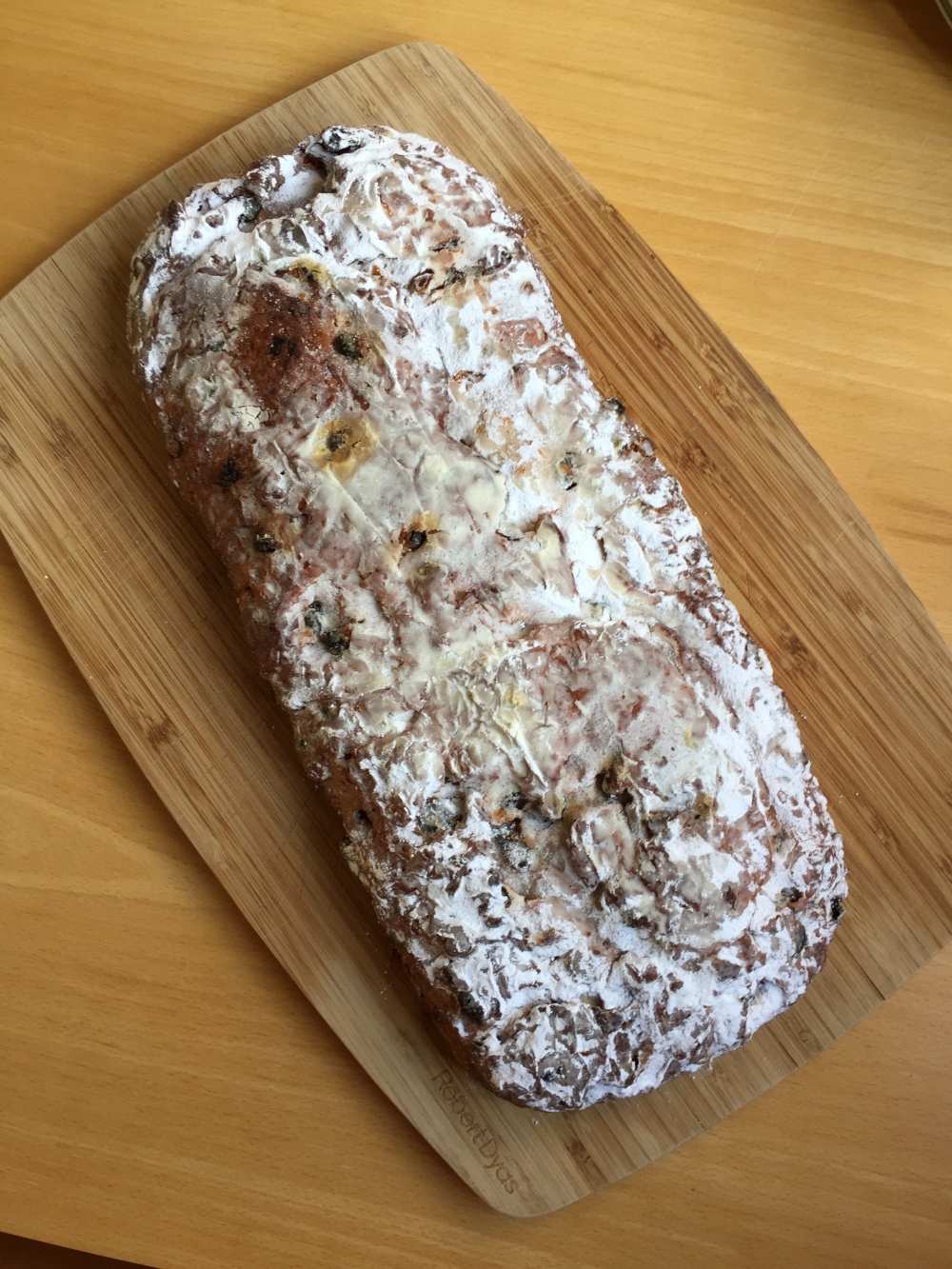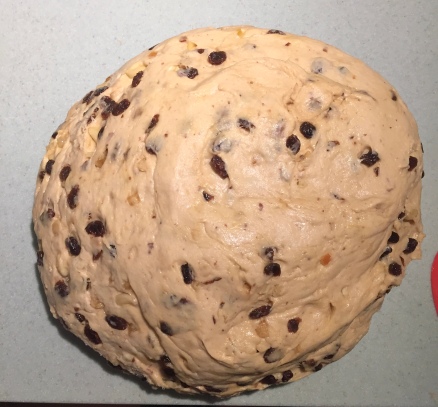So many of our Christmas traditions are in fact imports from Germany. The most notable import is the Christmas Tree which Prince Albert (Queen Victoria’s husband for those whose history is a little rusty) introduced in the mid 19th Century. The Stollen is another more recent addition. I have been asking around and I think it was really in the 80’s that it started growing in popularity in the UK, and frankly what’s not to like? Rum soaked raisins, spices and mixed peel in a sweet bread dough with a generous dusting of icing sugar and marzipan through the middle – it is the perfect Christmas cake.

The stollen has deep roots in German culture and goes back to the Middle Ages. It also has religious connotations. The more official name is the Christstollen and the shape is supposed to represent Christ swaddled in a blanket, though I think you have to stretch the imagination a little bit to see it.

The original stollen started in Dresden and was a rather plain bread made with oil. It was made on Advent Sunday and the Church at the time would have banned the use of butter and spices. In 1430 the Elector of Saxony (Dresden is the capital of Saxony) asked Pope Nicholas V permission to make the Advent bread with butter which was duly granted – solely for the Elector and his family. 50 years later Pope Innocent VIII lifted the restriction on the common people as long as they paid a twentieth part of a gold every year towards the church. Shortly after that Saxony turned protestant (which makes you wonder if the 2 events are connected) removing the Pope from any decisions at all on the matter and the spices, sugar and fruit got added to the recipe.

From the 16th century it became an annual gift to the Elector by the Dresden bakers. This reached its apogee in 1730 when Augustus the Strong (he who built most of the beautiful buildings that were destroyed in the War), who was a huge stollen enthusiast, ordered Dresden’s bakers to create a giant stollen for him. Some 100 bakers and their assistants combined 3,600 eggs (which the modern one does not have), 326 churns of milk and 20 hundredweight of flour to produce a giant stollen weighing around 1.8 tonnes that is said to have fed 24,000 people.
This event has led to the annual Stollenfest in Dresden on the first Saturday after Advent Sunday, where a giant stollen is paraded through the streets of Dresden to the Christmas market and then cut up with a huge knife and sold off for charity. I think we my have to go one year.
Whilst stollen started in Dresden there are other varieties. Dresden Stollen has no marzipan in it and is protected as a regional food under EU law, but I prefer the variety with marzipan. There is also Nut Stollen, Butter Stollen, Poppyseed Stollen, Quark Stollen, Persipan Stollen and a Thuringian variety from Erfurt called Schittchen which contains ground almonds rather than chopped and has a slit down the middle. Sadly I don’t have time to bake them all but here is the recipe I use (and If you don’t like Marzipan just leave it out).
The Recipe
The stollen is not a difficult bread to make, and because it keeps well can be made well in advance of Christmas. Indeed you should leave it at least a few days before even starting to eat it to allow it to settle and to let the the rum soaked raisins release their juices into the dough. It is also deliberately not proved too much which gives it the dense texture that marks put this bread.

The Ingredients
For the Stollen (one large or 2 small ones)
- 300g Raisins
- 150ml Dark Rum
- 600g Strong White Flour
- 10g dried instant yeast
- 250ml Milk
- 275g Unsalted Butter
- 60g Blanched Almonds (finely chopped)
- 125g Mixed Peel
- if you can get Orange and Lemon & Lime Candied Peel separately than use 75g Lemon & Lime Peel and 50g Orange Peel)
- 100g Sugar
- 200g White Marzipan
For the Icing Sugar and Butter top
- 75g Unsalted Butter
- 50g Icing Sugar
The Method
- soak the Raisins in the Rum overnight
- the next day ….
- line a large baking tray with baking parchment
- warm the milk to body temperature, add the yeast and leave for 20 minutes until you see the yeast beginning to be active
- combine all the ingredients except the rum and raisins and mixed peel and knead until you have a bread dough that holds together
- add the raisins, rum and mixed peel – this gets messy and the dough will get quite sticky until the moisture form the rum is taken up by the flour
- cover and allow to prove for about 90 minutes – about a 50% increase in volume
- flatten the dough using your fingers or a rolling pin onto the baking tray
- roll your marzipan into a rope the length of your dough and place on the middle of the dough
- fold one side of the dough over the marzipan to the edge and then fold the other side over that coming about 2/3rd over the other one, then seal the ends.
- cover and allow to prove for 30 minutes – you will not see a marked volume increase
- now heat your oven to 180C / 160C fan
- bake your stollen for 1 hour – if in doubt check it is cooked by measuring the temperature inside (avoid the marzipan). If it is 95C it is done.
- take your stollen out of the oven and allow to cool to body temperature
- place your stolen on a piece of aluminium foil large enough to wrap it (the next stage gets messy)
- melt the butter and brush all over the stollen
- heavily dredge the stollen in icing sugar until it is covered and and you can’t see any wetness from the melted butter
- wrap up tightly and store in a cool place for a least 2 days before eating
















